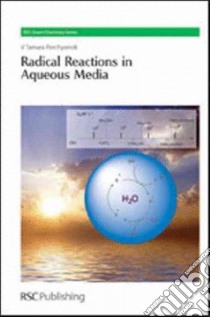- Libreria
- >
- Libri in lingua
- >
- Ingegneria
- >
- Scienza, ingegneria e tecnologia ambientale
Radical Reactions in Aqueous Media - 9781849730006
Un libro in lingua di Perchyonok V. Tamara edito da Royal Society of Chemistry, 2009
- € 98.60
- Il prezzo è variabile in funzione del cambio della valuta d’origine
Chemists are now moving away from volatile, environmentally harmful, and biologically incompatible organic solvents. With its low cost, ready availability, and capacity to remove environmentally unfriendly by-products, water is an obvious replacement. Recent advances in free radical chemistry in water have expanded the versatility and flexibility of homolytic carbon-hydrogen, carbon-carbon, carbon-halogen, carbon-nitrogen bond formations in aqueous media. This textbook highlights the substantial progress which has been made in the last decade to "tame" the reactive free radical species in aqueous phase reactions. It describes carbon-hydrogen bond formations in aqueous media via radical reactions with a specific focus on HAT (Hydrogen Atom Transfer). Suitable for students of chemistry, industrial chemists and academic researchers, it combines extensive knowledge of free radical chemistry with the latest innovations and creative applications. Divided into five main areas, it covers the: generation of carbon centred free radicals; radical initiators; solubility of substrate; suitability of free radical hydrogen donors, and HAT reactions in aqueous media. The book describes radical reactions in organic and aqueous media and their applications in total synthesis, DNA structural probing, isotope labelling, living polymerization and various other applications. It shows that, armed with an elementary knowledge of kinetics and some common sense, it is possible to harness radicals into tremendously powerful tools for solving synthetic problems. Written with the needs of students in mind, it offers just the right level of detail for undergraduate study. All the basic principles and facts on each topic area are presented in a concise yet comprehensive style that is appropriate for both core and specialist courses. It provides a step-wise introduction, taking students from the basic principles of radical reactions through to their applications in industry and their role in biological and environmental processes. Case studies are used to illustrate reactions in landmark synthesis and problems, with outlined answers, test the reader's understanding. There are also suggestions for further reading.
Informazioni bibliografiche
- Titolo del Libro in lingua: Radical Reactions in Aqueous Media
- Lingua: English
- Autore: Perchyonok V. Tamara
- Editore: Royal Society of Chemistry
- Collana: Royal Society of Chemistry (Hardcover)
- Data di Pubblicazione: 01 Dicembre '09
- Genere: SCIENCE
- Argomenti : Water chemistry Hydrogen bonding Chemical reactions
- Pagine: 129
- Dimensioni mm: 234 x 158 x 12
- ISBN-10: 1849730008
- EAN-13: 9781849730006


